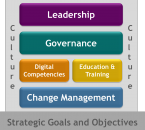[vc_row][vc_column width=”1/1″][vc_row_inner][vc_column_inner width=”1/4″ css=”.vc_custom_1424807277268{padding-top: 20px !important;}”][vc_column_text] [/vc_column_text][/vc_column_inner][vc_column_inner width=”3/4″ css=”.vc_custom_1424118256041{padding-top: 10px !important;}”][vc_column_text]Building on an assessment of where business schools are in their digital transformation journeys, this essay proposes a plan of action that will enable business school leaders to adapt to Digital Era realities and demonstrate Digital Era leadership. Guided by principles like the recognition that digital transformation is a marathon not a sprint, action items include having senior leaders participate in a Digital Transformation Masterclass, reviewing and revising the curriculum, and adding a digital dimension to research agendas and faculty expertise.[/vc_column_text][/vc_column_inner][/vc_row_inner][divider_line type=”divider_line”][vc_column_text]In an earlier article, I talked about how all business functions – not just customer focused areas like marketing and sales – are being transformed by social and digital technologies. The ideas I shared there complement my earlier discussions about how we’re all becoming tech workers and therefore need to have high degrees of digital literacy and competence.
[/vc_column_text][/vc_column_inner][vc_column_inner width=”3/4″ css=”.vc_custom_1424118256041{padding-top: 10px !important;}”][vc_column_text]Building on an assessment of where business schools are in their digital transformation journeys, this essay proposes a plan of action that will enable business school leaders to adapt to Digital Era realities and demonstrate Digital Era leadership. Guided by principles like the recognition that digital transformation is a marathon not a sprint, action items include having senior leaders participate in a Digital Transformation Masterclass, reviewing and revising the curriculum, and adding a digital dimension to research agendas and faculty expertise.[/vc_column_text][/vc_column_inner][/vc_row_inner][divider_line type=”divider_line”][vc_column_text]In an earlier article, I talked about how all business functions – not just customer focused areas like marketing and sales – are being transformed by social and digital technologies. The ideas I shared there complement my earlier discussions about how we’re all becoming tech workers and therefore need to have high degrees of digital literacy and competence.
As business functions and the related professional fields become increasingly transformed by social and digital technologies, there’s a corresponding need for the academic institutions that prepare the individuals who work in these areas to undergo their own digital transformations. In a more recent piece I offered a quick assessment of where business schools are in their digital transformation journeys, provide examples of the possibilities being exploited by some leading schools, and highlight areas that require greater attention.
This essay extends my earlier thinking by proposing a plan of action that will enable business school leaders to adapt to Digital Era realities and demonstrate Digital Era leadership.
Although focused on business schools, the ideas in this essay can also be applied to other professional schools like law, public health, social work, education, public administration, etc.
[/vc_column_text][/vc_column][/vc_row][vc_row][vc_column width=”1/1″][vc_column_text css=”.vc_custom_1424806642185{padding-bottom: 5px !important;}”]
Guiding Principles for Moving Forward
[/vc_column_text][vc_column_text]In developing a digital transformation plan of action, business school deans and other academic leaders should be guided by notions like the following:
- Digital transformation is a marathon, not a sprint – it will take a long time to become fully transformed
- The approach should be strategic, holistic and integrated – specific tactics and initiatives should clearly fit into the whole rather than be stand-alone efforts
- It’s important to proceed with mindful flexibility – having a clear sense of the ultimate objective and letting that guide decisions must be balanced with tolerance for ambiguity and chaos and the willingness and ability to change course when circumstances dictate
- Keeping the long-term goal in mind, shorter-term efforts can be pursued using a crawl-walk-run approach – not being able to do it all doesn’t mean you shouldn’t do anything
- Digital transformation requires leadership as well as followership – benchmarking and best practices are both important, but the “answers” are constantly evolving; there is also a need and opportunity to blaze trails, create new markets, and become first movers
[/vc_column_text][/vc_column][/vc_row][vc_row][vc_column width=”1/1″][vc_column_text css=”.vc_custom_1424806679820{padding-bottom: 5px !important;}”]
10 Action Items
[/vc_column_text][vc_column_text]With principles like the foregoing in mind, deans and other business school leaders should pursue the following:
Have senior faculty and key staff participate in a Digital Transformation Masterclass. The objective of this short, intensive course would be to provide an overview of significant Digital Era trends and their impact on economies, industries, businesses, leadership, organizational dynamics, and individual professions and careers. This course should be mandatory for everyone, even those who consider themselves to be digitally savvy. Ideally, senior staff will go through the course together; doing so will create a stronger foundation for future initiatives.
Solicit feedback from employers, advisory councils, and students at all levels. Armed with a general sense of the current and future state of business in the Digital Era, school leaders and key staff can then engage in rich dialogue with key constituencies about their biggest challenges and needs, and how business schools can help prepare for and address them.
Conduct benchmarking and other market analyses. Focusing on a small set of peer and aspirational schools, leaders can identify specific digital transformation efforts and ascertain prevailing best practices. Given that most schools haven’t gotten very far with their digital transformation efforts, however, this assessment may require focusing on schools that are at the leading edge and serving as first movers (e.g., MIT, Stanford, Wharton, UNC).
It may also be worthwhile to conduct a comparable analysis for select industries and organizations that serve as key targets and foci for the school. This analysis will complement the feedback previously received from key constituencies.
Business schools with undergraduate programs can also benefit from learning about digitally-focused initiatives at the broader institution, as well as at feeder schools like community colleges. Although it’s a bit more removed, understanding how secondary schools are preparing students to be digital citizens, workers, and leaders may also prove enlightening.
Review and revise the school’s mission, vision, and strategic goals. Using the feedback received from key constituencies along with the benchmarking and market assessments, leaders should determine whether and how these aspects of their operating mission should be updated to reflect how they want to be perceived as Digital Era leaders, and the corresponding initiatives they want to pursue.
Review and revise the curriculum. As an extension of their strategic commitments, leaders should evaluate programs of study and individual courses at all levels (i.e., undergraduate, graduate, executive education) to determine how they can and should be updated to incorporate the applications and implications of social and digital technologies. In addition to creating new majors and concentrations (e.g., Business Analytics, Community Management) and specific courses (e.g., Digital Era Legal Issues, Behavioral Finance in Cyberspace), it’s critical to fully integrate Digital Era realities into all courses in which they’re likely to have an impact, including the basic courses in law, management, human resources, accounting, and finance.
There is a particular need and opportunity for business schools to develop and deliver Executive Education programs focused on Digital Era leadership. Among other things, organizational leaders need guidance in determining the best approaches to incorporating digital technologies into strategy development and implementation, addressing new internal governance challenges and issues, developing sound approaches to managing change and navigating the cultural shifts arising from digital transformation, and adapting to new interaction expectations.
Add a digital dimension to research agendas and faculty expertise. With established research strengths as a baseline, school leaders can determine how the faculty’s expertise can be extended to incorporate social and digital technologies. Pursuing new research questions, methodologies and publication outlets can be encouraged via summer research and other grant programs, as well as support for conference participation and other travel. As much as possible, new research should emphasize the practical implications and applications of new technologies rather than a purely academic perspective.
In some schools, it may also be worthwhile to establish (or transform) centers and institutes to showcase digital expertise. Seeking sponsorship and developing partnerships with thought leaders, consulting firms and businesses with a commitment to digital transformation can also help create and develop digital expertise.
Leverage technology to enhance pedagogical practices, communication and collaboration. School leaders and faculty should continue to pursue efforts to integrate social and digital technologies into course delivery and assignments, as well as interactions with students. Doing this not only helps facilitate course management, but it’s also a great way to prepare undergraduates in particular for how they are likely to communicate and collaborate with others in the workplace.
As I noted in my previous essay, business schools should seriously consider developing and implementing a private social network. In addition to reducing the potential risks of using public channels for private communication (e.g., between teachers and students), these networks will enable students and faculty to communicate with each other outside the confines of a particular course and can also facilitate communication and collaboration among faculty and staff.
Provide ongoing digital literacy training and education. Digital transformation requires a digitally competent and literate workforce. Business school leaders should ensure that both faculty and staff have the knowledge, skills, and abilities necessary to be successful in their redefined roles. Rather than relying on LIY (Learn It Yourself) approaches, which are unreliable and often ineffective, this may require formal training programs and ongoing education.
Update performance management practices to reflect the emphasis on digital transformation. Recognizing that people focus on the activities for which they get evaluated and rewarded, school leadership must revise performance management practices to reflect new expectations regarding digital expertise and engagement.
Develop a plan for continuous innovation. Not only is digital transformation a marathon, it’s a “race” that never ends. Given that, school leaders must ensure that faculty and staff remain current and maintain their commitments to and expertise in the impact of social and digital technologies on businesses and the people who populate them.[/vc_column_text][/vc_column][/vc_row][vc_row][vc_column width=”1/1″][vc_column_text css=”.vc_custom_1424806716981{padding-bottom: 5px !important;}”]
Conclusion
[/vc_column_text][vc_column_text]Is this a big undertaking? Absolutely. That’s why it’s important to remember that it’s a marathon not a sprint, and to move forward with a crawl-walk-run approach guided by an integrated, holistic strategy.
As always I welcome your thoughts on the digital transformation of business (and other professional) schools. How important do you think it is for them to integrate Digital Era realities into their curricula, pedagogical approaches, research agendas, and operations? What do you consider the most important areas for business school leaders to focus on? What other principles should guide their efforts? How critical is it for them to have a plan of action? How soon should they get started?
This essay originally appeared on Social Media Today as part of their Best Thinkers program.[/vc_column_text][divider_line type=”divider_line”][/vc_column][/vc_row]





